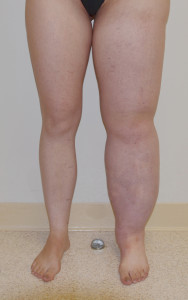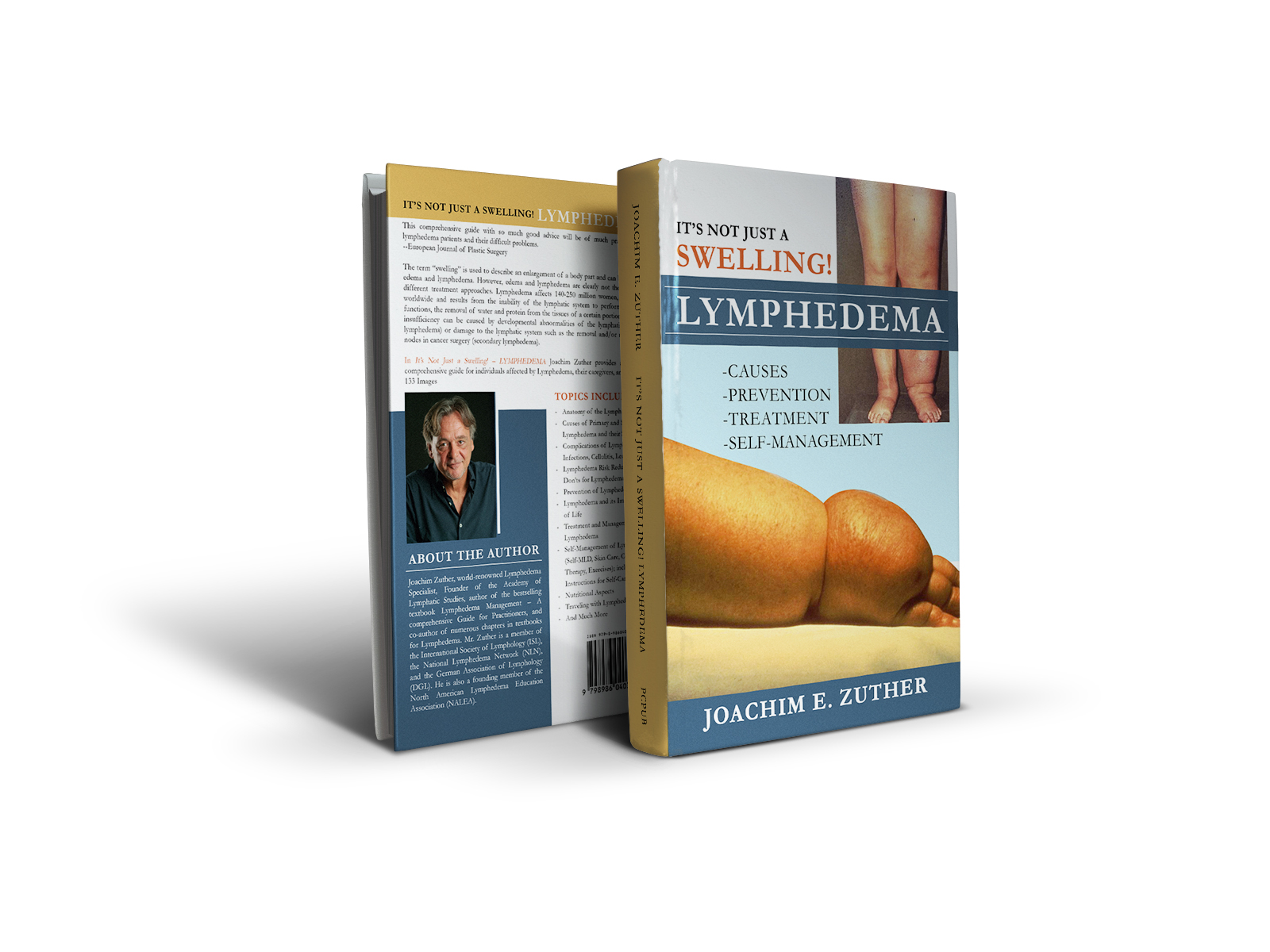Lymphedema is very common and serious condition that affects millions of individuals. While there is no consistency in the data of the overall incidence of lymphedema in the United States, it is estimated that at least 3 million Americans are affected by this condition.

Primary (congenital) lymphedema of left leg
Lymphedema is classified as either primary or secondary. Primary lymphedema is caused by congenital malformations of the lymphatic system and usually affects the lower extremities. It may be present at birth, but more often develops later in life, often in puberty or during pregnancy.
Secondary lymphedema is much more common; most patients in the western hemisphere develop lymphedema after surgery and/or radiation therapy for various cancers (breast, uterus, prostate, bladder, lymphoma, and melanoma). Other patients develop lymphedema after trauma or deep vein thrombosis. In certain countries, parasites (filariasis) account for millions of cases of lymphedema. Its cosmetic deformities are difficult to hide, and complications, such as fibrosis, cellulitis, lymphangitis, lymphorrhea, etc. do occur frequently. Lymphedema may be present in the extremities, trunk, head and neck, abdomen, the external genitalia as well as in inner organs; its onset is gradual in some patients and sudden in others.
The focus of this article is to discuss the role of nutrition as an additional approach to manage lymphedema effectively.
Nutritional Aspects:
There is no special diet for lymphedema. An accepted nutritional approach in the management of lymphedema is to follow a balanced diet, which in addition to physical activity and exercises promotes weight loss. Excessive weight contributes to greater demands on the lymphatic systems ability to drain fluid from the tissues; weight control therefore positively affects lymphedema.
 Studies indicate that obesity does have an influence on lymph fluid level and extremity volume (1, 2). Obesity and overweight often worsen the symptoms associated with lymphedema; a nutrition balanced and portion appropriate diet contributes in reducing the risk factors associated with lymphedema.
Studies indicate that obesity does have an influence on lymph fluid level and extremity volume (1, 2). Obesity and overweight often worsen the symptoms associated with lymphedema; a nutrition balanced and portion appropriate diet contributes in reducing the risk factors associated with lymphedema.
A balanced healthy diet including whole grains, fish, fruits and vegetables and avoiding fatty foods will greatly assist in achieving and maintaining a healthy weight without restricting the intake of important nutrients and vitamins. Crash diets or diets which restrict certain food groups and nutrients are not advisable.
There is a common misconception that lymphedema may be positively affected by limiting the protein intake. This is not the case – although lymphedema is defined as an accumulation of water and protein in the tissues, it is essential to understand that lymphedema cannot be reduced by the limitation of protein ingestion, which can even be potentially dangerous. It is also important not to limit fluid intake in an attempt to reduce the swelling. Good hydration (water) is essential for basic cell function and especially important before and after lymphedema treatment to assist the body in eliminating waste products.
Fluid and Sodium for Lymphedema
Lymphedema, like other edemas appears to benefit from a low salt diet, but when it comes to fluid intake, lymphedema sets itself apart from other edemas. Click here for more information on Fluid and Sodium for Lymphedema.
Diuretics
Diuretics promote excess fluid in the body to be excreted. Although diuretics may be beneficial in the short-term, and may be indicated in those cases when lymphedema is associated with systemic conditions (ascites, hydrothorax, protein-loosing enteropathy), they may be harmful and contribute to the worsening of lymphedema-related symptoms if used long-term.
Here is why: Lymphedema is an abnormal accumulation of water and protein molecules in the body’s soft tissues, which is caused by a dysfunction of the lymphatic system. Swelling (edema) other than lymphedema may be caused by a variety of conditions, such as congestive heart failure, renal diseases, or venous insufficiencies. These swellings do not contain a higher level of proteins in the accumulated fluid, and are defined as edemas.
Diuretics used for lymphedema are limited to remove the water content of the swelling, while the protein molecules remain in the soft tissues. The dehydration effect of diuretics causes a higher concentration of the protein mass in the edema fluid, which may cause the tissues to become more fibrotic and increase the potential for secondary inflammations. In addition, the remaining proteins characteristically draw more water to the swollen areas as soon as the diuretic loses its effectiveness and may cause the volume of the lymphedema to increase.
The 2009 Consensus Document (4) of the International Society of Lymphology states: “Diuretic agents are occasionally useful during the initial treatment phase of complete decongestive therapy (CDT). Long-term administration, however, is discouraged for its marginal benefits in treatment of peripheral lymphedema and potentially may induce fluid and electrolyte imbalance”
What about Vitamins and other Supplements?
There are no vitamins, food supplements or herbs that have been proven to be effective in the reduction of lymphedema. In the United States, dietary supplements are regulated as food, not drugs. Pre-market approval by the Food and Drug Administration (FDA) are not required unless specific disease prevention or treatment claims are made. Because there is no requirement to review dietary supplements for manufacturing consistency, and no specific standards for dosage or purity exist, there may be considerable variation within the products marketed as dietary supplements.
However, individuals affected by lymphedema are often in need of additional vitamins and supplements, especially if they battle recurrent episodes of infections. To determine which supplements and vitamins are beneficial, patients should consult with their physicians and/or nutritional specialist.
Dear Lymphedema Blog Reader – if you like the contents on this website, please help to keep it going. A great amount of work and research is necessary to provide you with up-to-date information on this site. Your donation supports these efforts and associated administrative costs. Surplus funds will be donated to Lymphedema/Lipedema-related charitable endeavors. Please donate using the “Donate Now” button on the right upper hand of this page – Thank You!
Join Lymphedema Guru, a Facebook page solely dedicated to informing about all things related to lymphedema – news, support groups, treatment centers, and much more
Additional reading: https://jeanlamantia.com/cancer-bites-diet-blog/lymphedema-diet/
Literature on that topic:
Lymphedema and Lipedema Nutrition Guide http://www.lymphnotes.com/pubpage.php/id/634/
References:
- Fu MR, Axelrod D, et al. Patterns of Obesity and Lymph Fluid Level during the First Year of Breast Cancer Treatment: A Prospective Study. J. Pers. Med. 2015, 5(3), 326-340; doi:10.3390/jpm5030326
- Helyer LK, Varnic RN, Le LW, Leong W, McCready D (2009) Obesity is a risk factor for developing postoperative lymphedema in breast cancer patients. Breast J16(1):48–54
- Dawson R, Piller NDiet and BCRL: facts and fallacies on the web. Journal of Lymphoedema, 2011, Vol 6, No 1 http://www.journaloflymphoedema.com/media/journals/_/1107/files/jol6-1-36-42.pdf
- International Society of Lymphology Consensus Document on the Diagnosis and Treatment of Peripheral Lymphedema. Lymphology 42 (2009) 51-60 http://www.u.arizona.edu/~witte/2009consensus.pdf


 Joachim Zuther, Lymphedema Specialist.
Joachim Zuther, Lymphedema Specialist. 
